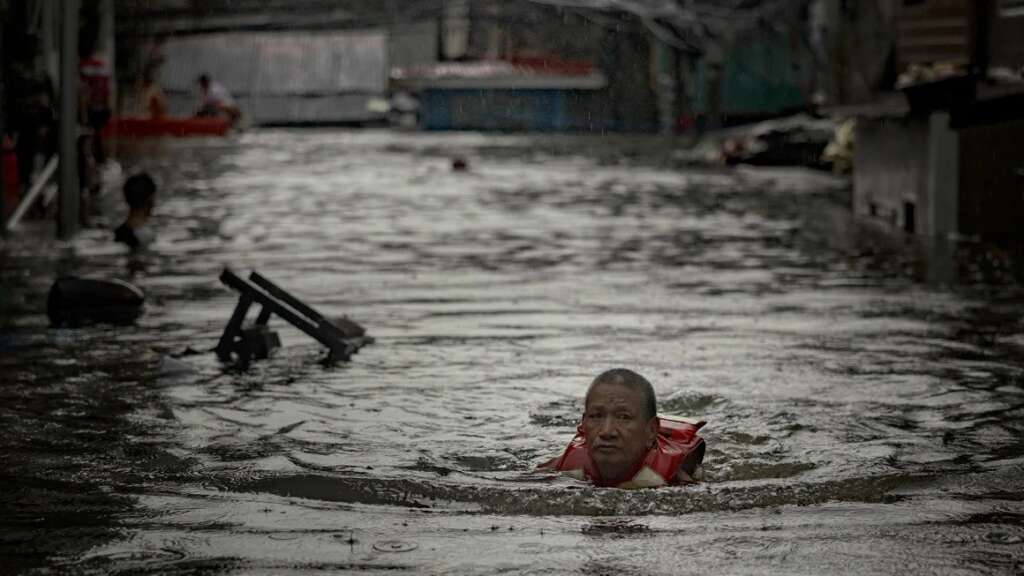On July 24, 2024, while Typhoon Gaemi did not make landfall in the Philippines, it brought torrential rains and powerful winds to Metro Manila. This event drew immediate comparisons to Typhoon Ketsana from September 2009, highlighting both the importance in flood risk management and the escalating challenges posed by climate change.
Much of the Philippine capital remained submerged on Thursday after Typhoon Gaemi intensified the torrential monsoon rains, trapping thousands in rising floodwaters and causing widespread damage. The relentless heavy rains, massive flooding, and landslides have claimed at least 13 lives and displaced over 600,000 residents across the country. Additionally, an oil tanker capsized off the coast amid strong winds and high waves, according to Philippine authorities.
Unlike in Taiwan, where the typhoon made landfall, Gaemi—known locally in the Philippines as Carina—did not directly hit the Philippines. However, its powerful outer bands dumped over 300 mm (12 inches) of rain on the Manila region and parts of Luzon. This prompted officials to declare a “state of calamity” in the capital on Wednesday and evacuate tens of thousands of people.
In conjunction with the southwest monsoon and Tropical Storm Prapiroon, heavy rains drenched southern and northern Luzon, triggering widespread flash floods across the region. This exacerbated the situation, catching those in Luzon off guard.

Comparing Typhoon Gaemi to Typhoon Ketsana
Typhoon Ketsana, known locally as Ondoy, unleashed unprecedented rainfall over Metro Manila, causing widespread flooding that submerged homes, roads, and infrastructure. The storm left a lasting impact, displacing thousands and highlighting vulnerabilities in urban planning and disaster response.
Despite nearly 15 years of efforts to improve flood risk management, Metro Manila was still unprepared when Typhoon Gaemi hit. The Manila Bay reclamation projects, coupled with the effects of climate change, have negatively impacted the city’s flood defences. As a result, Typhoon Gaemi’s effects were almost comparable to those of Typhoon Ketsana, even though Gaemi affected the region for a shorter period. Areas that had not flooded during Ketsana experienced severe flooding during Gaemi, revealing the worsening conditions.
In Cainta, Rizal province, located east of the capital, floodwaters remained at waist level on Thursday, according to local councillor Ben Ramirez Narag.
“No one is prepared for this, even though we anticipated the typhoon, we could not have predicted the scale of rainfall,” he said.
The Importance of Flood Risk Management
Flood risk management is crucial in Metro Manila due to its vulnerability to frequent and intense flooding. The city’s geographical location, combined with rapid urbanisation and inadequate infrastructure, amplifies its susceptibility to flooding during typhoon seasons and heavy monsoon rains.
Effective flood risk management is essential not only to protect lives and property but also to safeguard critical infrastructure, maintain economic stability, and preserve environmental integrity. In recent years, the impact of climate change has exacerbated these challenges, highlighting the urgent need for comprehensive flood mitigation strategies and sustainable urban planning to enhance resilience and ensure the well-being of Metro Manila’s residents.
Climate Change and Typhoon Intensity
Climate change accelerates the intensity of typhoons like Gaemi. Warmer ocean temperatures fuel more powerful storms, while changing wind patterns alter their paths. This phenomenon isn’t isolated to the Philippines but affects global weather patterns, increasing the likelihood of extreme weather events.
Addressing climate change requires a multi-faceted approach: reducing greenhouse gas emissions, adapting infrastructure to withstand severe weather, and investing in sustainable urban planning. The urgency of these measures is clear as communities worldwide face escalating risks from natural disasters.
Typhoon Gaemi’s impact on Metro Manila serves as a stark reminder of the interconnected challenges posed by climate change and rapid urbanisation. While progress in flood risk management has been made since Typhoon Ketsana, the need for adaptive strategies and international cooperation is more pressing than ever.
As the Philippines and other vulnerable nations continue to face escalating climate risks, concerted efforts in disaster preparedness, sustainable development, and global climate action are paramount. Only through collective action can we mitigate the impacts of future typhoons and build a resilient future for all.
Donations
If you would like to donate to the victims of Typhoon Gaemi, please visit this site. Your generous contributions will provide essential support to those affected, including emergency supplies, shelter, and medical aid. Every donation, no matter the size, makes a significant difference in helping communities rebuild and recover from this devastating natural disaster. Thank you for your compassion and support during this critical time.
FEATURED IMAGE: Ezra Acayan/Getty Images



